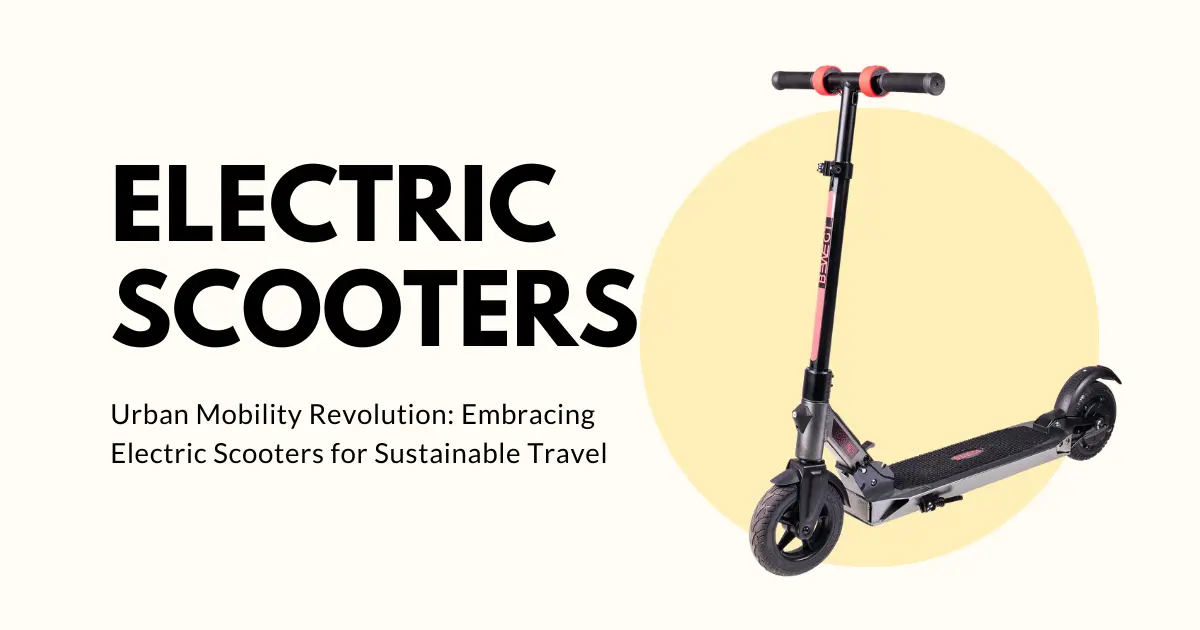Introduction: Paving the Way for Electric Scooters
A modern-day electric scooter is a type of personal transportation device powered by electricity. These scooters typically have a small electric motor, a rechargeable battery, and a platform for the rider to stand on. They are designed for short-distance travel and are often used for commuting or leisure rides in urban areas. Electric scooters are popular for their eco-friendly nature, as they produce zero emissions during operation.
Convenience Redefined: The Allure of Electric Scooters
Electric scooters are revolutionising urban travel convenience. Because of their flexibility, riders can move quickly through traffic, avoiding delays and arriving at their destinations.Electric scooters’ portability, with the ability to fold up easily for storage and transportation, renders them incredibly convenient for multi-modal transportation and small living areas.
Green Mobility: The Environmental Benefits of Electric Scooters
In a time when environmental worries are prevalent, electric scooters provide a welcome change of pace. These rechargeable battery-powered scooters generate no pollutants, improving air quality and lowering carbon footprints in cities. Riders of electric scooters can significantly reduce the environmental effect of urban transportation by selecting them over gas-powered cars.
Safety in Motion: Prioritising Rider Safety
Although electric scooters are a cost-effective and environmentally sustainable form of transportation, safety is still the first priority. Riders must wear helmets, obey traffic laws, and ride carefully.Manufacturers are always upgrading its safety features—like better brakes and lighting—to make riding safer for riders of all ages.
The Future Unfolds: Electric Scooters in Tomorrow’s Cities
Communities adopting creative solutions to transportation-related problems position electric scooters as a crucial component of urban mobility systems. With continuous improvements in infrastructure and technology, electric scooters provide a window into a future where transportation is more accessible, greener, and cleaner for everyone. Cities can set the path for a livelier and more sustainable urban environment by embracing electric scooters. Become a part of the electric scooter revolution by joining the movement today!
Conclusion: Shaping Tomorrow’s Cities, One Scooter at a time
Electric scooters are more than just a means of transportation; they are a symbol of an accessible, economical, and ecological urban mobility future. Electric scooters present a viable answer to the traffic, pollution, and need for more environmentally friendly transportation options that cities throughout the world are facing.
An electric scooter, sometimes referred to as an e-scooter, is a personal electric vehicle with an electric motor and a rechargeable battery. Typically, it has handlebars for steering, a platform for the rider to stand on, and accessories like brakes and lights.
Rechargeable batteries are used to power an electric motor in electric scooters, which drives the scooter forward. Using handlebar controls, riders may adjust the scooter’s direction and speed.
An electric scooter’s range is influenced by a number of variables, including speed, topography, rider weight, and battery capacity. Electric scooters typically have a range of 10 to 50 kilometres between charges.
Although the peak speeds of electric scooters vary by model, most of them fall between 10 and 30 miles per hour. Nevertheless, the maximum speeds of some models could be greater or lower.
Electric scooter legality is subject to local laws, which differ depending on the jurisdiction.In general, electric scooters are allowed for use on sidewalks and public highways; however, local laws may regulate helmet usage, speed limits, and permitted riding zones.
Riding an electric scooter typically does not require a driver’s licence. However, riders might have to abide by age limitations and other rules established by local government bodies.
Usually, the manufacturer supplies a charger that users can use to charge an electric scooter by connecting it to a regular electrical socket. Depending on the charger requirements and battery capacity of the scooter, different charging times apply.
When operated sensibly, in compliance with traffic regulations and safety standards, electric scooters can be quite safe. To reduce the chance of an accident, riders should wear helmets, stay in approved riding locations, and pay attention to other cars and pedestrians.
Even though a lot of electric scooters can withstand some water, riding in the rain or over puddles might harm the scooter’s components and put users in danger. In general, it’s best to stay away from riding electric scooters in the rain.
Riders who choose electric scooters over gas-powered automobiles can contribute to the fight against climate change and air pollution reduction.




